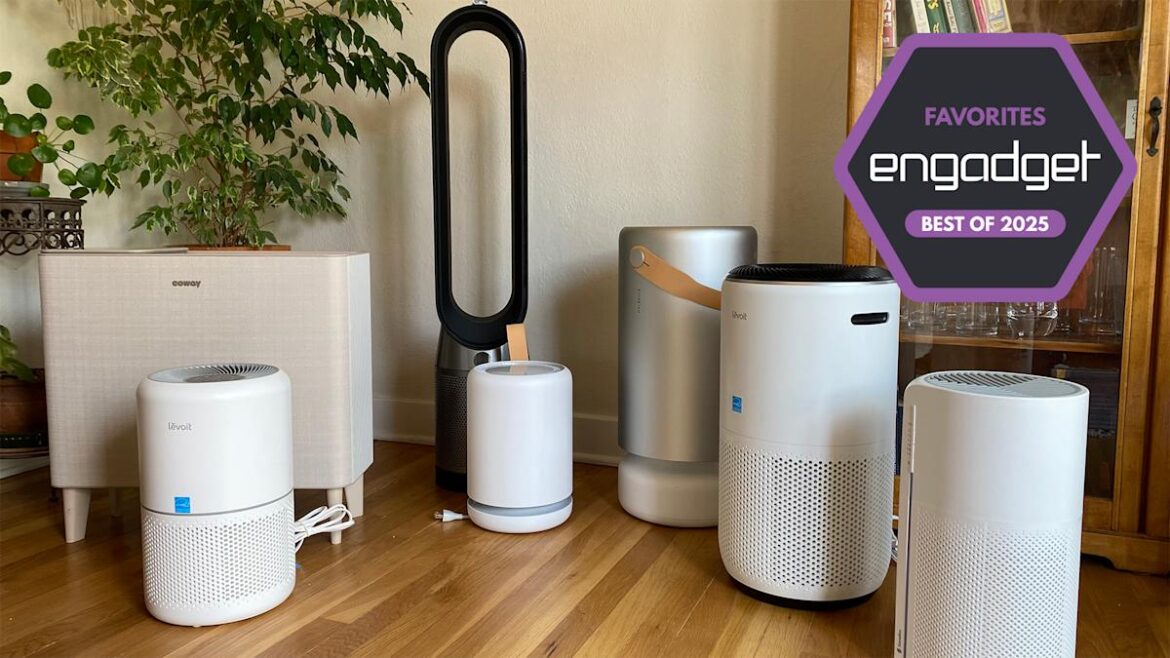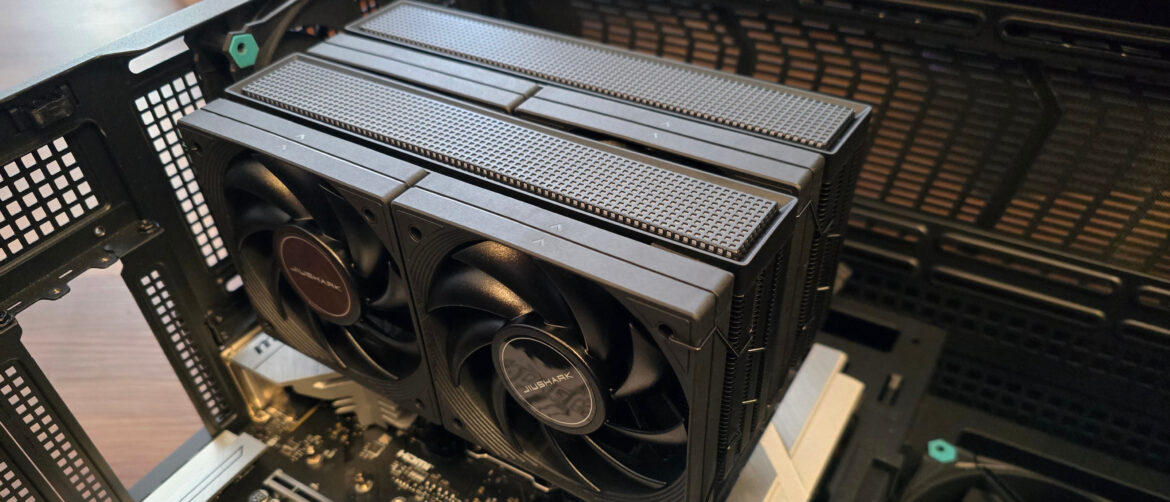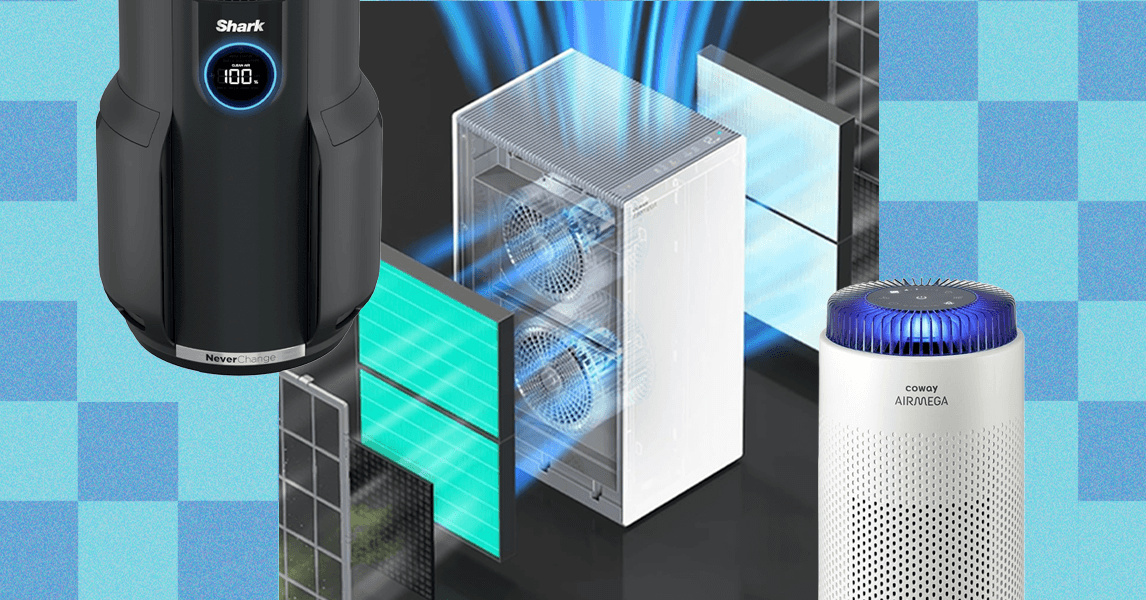The air in our homes can be five times more polluted than outdoor air. Energy-efficient homes are designed to be tightly sealed, too, so they trap more pollutants inside. Cooking emissions, cleaning chemicals and fragrances all contribute to less-than-healthy air. Pets, smoke and off-gassing furniture do their part as well. If the air quality outside is good, the best thing to do is open up your windows for at least 15 minutes a day. But if wildfires, car pollution, or high pollen counts prevent you from letting in fresh air, an air purifier may be your best bet. These machines can reduce pollutants, remove odors and trap some bacteria and mold. We tested over a dozen to see how they perform and how nice they were to live with. Here are the best air purifiers we could find.
Table of contents
Best air purifiers for 2025
Photo by Amy Skorheim / Engadget
Filters: Pre, activated carbon, HEPA | Auto Mode: Yes | App-connected: Yes | Sleep Mode: Yes | Coverage area in 30 minutes: 1,000 sq.ft. | Max decibels: 64 | Weight: 14 lbs | Filter replacements: $50
The Levoit Core 400S Smart Air Purifier isn’t trying to be anything fancy. It’s a simple white cylinder with holes for air intake and a black ring of vents on top. Touch controls in the center of the vents are easy to suss out, letting you adjust the fan speed, enable auto mode and turn on a sleep setting, which drops the fan to the lowest intensity and shuts off the display lights. The internal sensor measures particulate matter at 2.5 microns, which displays in the center of a lighted ring near the controls. The ring turns blue when all is well and moves through to green, orange and red as air quality levels deteriorate. In auto mode, when it detects a drop in air quality, the fan increases speed until levels go back down.
Even at its highest level, the fan isn’t terribly loud, peaking at around 62 in the Decibel Meter app and leaving my cat undisturbed on the couch nearby. Yet the force of the air coming out is strong and feels on par with output from purifiers that are quite noisy (which made the cat run away).
The Core 400S claims a half-hour air exchange rate for a 1,000-square-foot room and combines the three main filter types — pre-filter, activated carbon and HEPA — into a single ring. Perhaps the best part is a replacement filter is only $50, half the price of some competing brands. In multiple burn tests, the Core 400S reliably got the room back to its starting level in about a half hour of running on high. Auto mode does a good job of reacting to drops in quality, kicking on to a higher fan level nearly every time someone in the house cooks and after an incense burn.
This true HEPA air purifier connects to the VeSync app; setup is easy, but the app itself is overpacked. There’s a forum, a wellness tab and a shopping page where you can buy not just Levoit products, but also devices from sister brands Etekcity and others. But as far as controlling the Core 400S itself, the in-app controls are easy to use and nicely laid out.
Pros
- Easy on-board controls
- Reliably improved the air quality in our tests
- Inexpensive replacement filters
- High speed is powerful, but not overly loud
Cons
- The companion app is over-stuffed
- Ho-hum design
$182 at Amazon
Photo by Amy Skorheim / Engadget
Filters: Pre, activated carbon, particle | Auto Mode: Yes | App-connected: Yes | Sleep mode: Yes | Coverage area in 30 minutes: 547 sq.ft. | Max decibels: 58 | Weight: 6 lbs | https://www.standards.doe.gov/standards-documents/3000/3020-astd-2015: $36-40
The best pick for a tiny room turned out to be the mini version of our overall pick: the Levoit Core 300S. Manufacturers recommend elevating smaller air purifiers on a table or stool — where you’re even more likely to notice them. From a looks perspective, I prefer Molekule’s Air Mini+ better, but Levoit’s model goes for nearly $200 less and replacement filters are a third of the price. The Air Mini+ did perform slightly better than the 300S in my burn test, but the results were very close — and when you’re dealing with measurements in the parts-per-million, a difference of a hundred or so in the numbers is near negligible.
Simple controls at the top of the Core 300S turn on auto mode, adjust fan speed and more. You don’t get the PM meter readout that the larger unit has on this model, but you still have the lighted ring that shines blue when the air is clear and goes to red when things get unhealthy. Of course, you can always head to the app to see the PM2.5 measurement, as well as to do things like set schedules and timers and enable different auto modes. You can turn on a quiet auto mode, which will raise the fan speed when air quality goes down, but won’t ever use the highest fan speed. There’s also an efficient mode that lets you set the size of the room and it will blast the highest fan speed for the amount of time it takes to do one air exchange, before dropping back down to low — sort of like an on-demand reset for the room.
The lowest setting is remarkably quiet, which makes it good for small rooms like home office or bedrooms. Unless the room is fully silent, I have to hold my hand over the vents to make sure it’s on. The highest speed isn’t terribly loud at around 58 decibels, yet the air comes out forcefully.
Pros
- Simple on-device controls
- Low mode is very quiet
- Inexpensive replacement filters
Cons
- Fairly uninspired white plastic cylinder design
$150 at Amazon
Amy Skorheim for Engadget
Filters: Pre, activated carbon, HEPA | Auto Mode: Yes | App-connected: Yes | Sleep mode: Yes | Coverage area in 30 minutes: 975 sq.ft. | Max decibels: 74 | Weight: 21 lbs | Filter replacements: $60
If you’ve indicated any interest in air purifiers during your online travels, there’s a good chance you’ve seen ads for Windmill. Like Molekule machines from a couple of years ago, these things are (digitally) everywhere.
A big part of the appeal is aesthetics. Windmill models come in white, navy or bamboo finishes and, instead of the usual cylindrical tower shape, these have a squat, oblong design. Air is only pulled in through one side, which happens to be the side opposite the controls, so you’ll have to be careful about where you put it to ensure it gets enough airflow. It’s also unusually heavy at 21 pounds. Models with similar room-size ratings are often half that weight.
The app is pretty spare, with fan and mode controls, along with a particle meter readout, a few device settings and automations for setting schedules. The device itself has buttons and LED pips for fan and mode control and a small indicator light that changes from green to red to signal the air quality (Windmill also uses PM only to gauge the air).
In my tests, the Windmill more efficiently cleared the VOCs from the room when it was on lower fan settings. I suppose that makes sense in a way, as slower moving air spends more time passing through the carbon layer, which should theoretically trap more chemicals — but this was the only purifier I noticed that seemed to prove that theory.
There’s also a boost mode if you need to clear a bunch of air at once. It was one of the loudest fan speeds I tested, clocking in at 74 decibels on my sound meter app, but the lowest fan speed is inaudible. I appreciated that there are two sleep modes, whisper and white noise, with the latter setting the fan speed to what sounds like between medium and high and shuts off the LED lights.
Both Blueair and the Levoit Core models performed better overall than the Windmill — and both are cheaper — but if having an air purifier that doesn’t look like it belongs in a doctor’s office is important to you, this is an attractive way to go.
Pros
- Attractive design
- Simple set up
- The app is easy to use
Cons
- More expensive than other, higher-performing options
$399 at Amazon
Amy Skorheim for Engadget
Filters: Pre, activated carbon, HEPA | Auto Mode: Yes | App-connected: Yes | Sleep mode: Yes, plus white noise/night light | Coverage area in 30 minutes: 300 sq.ft. | Max decibels: 64 | Weight: 6.4 lbs | Filter replacements: $40
In January of this year, Levoit added this cute, kid-focused model to its air purifier lineup — that already includes two of our top picks. The Levoit Sprout combines air purification with a nightlight and basic white noise functions in a petite package. The app gives you full control over the lights, sounds and purifier settings, but the onboard controls are equally effective — important for parents who need to quickly make bedtime adjustments without having to hunt down their phone.
I set it up in my kids room and was pleased with the simple but perfectly adequate sleep functions. Rain, waves, music and forest sounds can be combined with a soft amber light which you can set to turn off after a few minutes or up to an hour. And all the functions, from fan speed to light levels and sound can be scheduled within the app as well.
Of course, these features would be pointless if the air purification wasn’t up to snuff — but in my testing, it was able to clear out the incense smoke from a bedroom as quickly as larger machines. Possibly my favorite part of the machine is the internal air quality sensor. Most purifiers with an auto setting just detect particulate matter; this one measures particulates in three different micron measurements as well as VOCs, humidity, temperature and CO2 levels. After cooking, when my AQ monitor showed VOC levels spiking, other purifiers blissfully thought all was well, but the Sprout’s auto setting kicked the purifier into high gear.
At $280, it’s actually more expensive than its bigger sibling, our top pick the Levoit Core 400S, but that model lacks the extra sensors — and the charming sleep functions.
Pros
- Includes a nightlight and sleep sounds
- Has a VOC, temperature, humidity, CO2 and PM sensors
- Great cleaning performance for the price
$280 at Amazon
Amy Skorheim for Engadget
Filters: Pre, activated carbon, HEPASilent | Auto Mode: Yes | App-connected: Yes | Sleep mode: Yes | Coverage area in 30 minutes: 929 sq.ft. | Max decibels: 69 | Weight: 7.8 lbs | Filter replacements: $45
Figuring out whether slick marketing terms translate to actual performance is a big part of testing gadgets. Blueair’s buzzterm is HEPASilent, a process that adds an electrostatic charge to particles that enter the filter. The particles are then more apt to cling to the multi-surface structure of the filter and become trapped. Because the pollutants are stickier, the filter itself is less dense, so the fan doesn’t need to work as hard to pull the air through — and the fan is the noisy part of any purifier.
In my testing, the Blueair Blue Pure 311i Max did outperform other models when it came to reducing PM levels after an incense burn. It wasn’t quite as good at lowering the VOC levels compared to other units, however, landing somewhere in the middle of the results range.
The device itself has an attractive, minimalistic design. Instead of an all-plastic tower, the Blue Pure has a softer appearance thanks to the mesh fabric prefilter that covers the bottom three-quarters. Prefilters are an air purifier’s first line of defence, catching the biggest bits like pet hair and larger dust specks, so it’s nice that this one is vacuumable, removable and even washable.
I tested the standard filter model, but Blueair also sells filters for specific pollutants: one for dust and one for allergens. The smoke-focused model has more activated carbon, which could help it remove VOCs better. But, instead of $50 a pop, those filters are $65 and $70 apiece, respectively.
Both the onboard controls and the app are no-frills, letting you control the fan speed and turn on the sleep or auto mode. Like other air purifiers, the included sensor relies on elevated particular matter to kick in the automatic cleaning mode. In addition to scheduling, the app can also detect when you’re on the way home and start up the machine before you arrive. That means giving the app location permissions that it uses at all times — not just when you’re using the app — which could be a battery drain on your phone.
The price is reasonable at $230, but the overall filtering performance of the Levoit Core 400S was slightly better, leading me to keep it in its top spot on our list. Still, there’s a lot to like about Blue Pure.
Pros
- Good at cleaning particulate matter
- Attractive design
- Comparatively affordable price
- External, washable pre-filter softens the look
Cons
- VOC cleaning performance not as strong
$185 at Amazon
Photo by Amy Skorheim / Engadget
If, like me, you’re obsessed with the recent conversations surrounding the gut biome, you might find yourself wondering what else industrious bacteria can do. The team at Neoplants must have wondered the same thing, because they recently released a potted pothos houseplant, called Neo Px, that uses engineered soil bacteria to help the plant absorb and break down three harmful VOCs: benzene, toluene and xylene. The chemicals can be found in cigarette smoke, wildfires, adhesives, solvents, petroleum products and cleaning products — and their effects range from headaches and dizziness to increased cancer risk.
I got a chance to try one out and am intrigued by both the concept and the execution. Unfortunately, the consumer-grade equipment I have on hand isn’t sophisticated enough to actually test the plant’s effectiveness. As Neoplant’s CTO explained to me, home AQ monitors ping on a few select VOCs and extrapolate from those measurements a general sense of a room’s total chemical levels.
This is one instance in a product review when I’m relying on evidence offered up by a company instead of first-hand testing. But the data in Neoplants’ whitepaper is pretty comprehensive, and includes results from experiments designed and run in collaboration with the Energy Environment Research Center at IMT Nord Europe, a French graduate school of engineering. The short version of the results is that one Neo Px amounts to the same air-filtering abilities of 30 similarly sized plants.
The plant itself is the humble (and hard-to-kill) pothos, with lots of large leaves to help in the process of air purification. The Neo Px pot is pretty clever in itself, with a reservoir-and-wick watering system that tells you when it needs more water — something I wish all my plants could do. Ventilation at the bottom of the pot exposes the soil to air, which is key to increasing the filtering action as the roots and soil have been shown to do most of the heavy cleaning.
To increase what that soil can do, Neoplant scientists tweaked the microbial ecosystem by forcing a strain of rhizosphere (root-adjacent) bacteria to undergo thousands of forced evolutions. After exposing the bacteria to high concentrations of VOCs, they bred the survivors and repeated the procedure over the course of five years.
The plant you’re shipped (in brilliantly protective packaging) has high concentrations of the bacteria already at work. But as the plant goes about its life, eating chemicals and soaking up sunshine, the microbiome activity decreases, which is why a six-month supply of powdered bacteria ships in the box. Once per month, you mix the Power Drops (a substance that looks and faintly smells like powdered coffee creamer) with water in the little included glass beaker and add it to the soil.
Just recently, NeoPlants released a version of Power Drops for use with any houseplant (just not succulents) to boost the air cleaning capabilities.
If you go for the whole plant, it should last for years with minimal maintenance, as pothos do, but the Power Drops make up an ongoing cost associated with a Neo Px, to the tune of about $60 to $120 per year, depending on whether you subscribe for auto-refills. That’s on par with the range for filter replacement costs on most standard air purifiers.
Then there’s the initial cost of either $119 or $99, depending on whether you sign up for regular deliveries of the soil bacteria. That’s cheaper than a standard air purifier, but a little pricier than a houseplant, which you can find online for between $40 and $80, for around $20 at your local plant store, or practically free if you snag a cutting from a friend and an old pot.
Of course, no matter how good a plant is at sucking up toxins, it can’t deal with particulate matter, one of the two air quality issues regular purifiers address. Still, it’s a great looking, abundant pothos with a long shelf life, a clever watering system and some friendly bacteria that silently suck in some of the VOCs in your air in the most energy-efficient way possible.
Pros
- Needs no electricity
- Low maintenance plant with a long life span
- Clever pot design indicates water needs
- Neoplants experiments show its effective at removing certain VOCs
Cons
- Does not clean particulate matter
- Somewhat expensive for a houseplant
- Requires monthly addition of Power Drops to be most effective
$119 at Neoplants
What an air purifier can and can’t do
There are three key categories of air pollution that adversely affect the quality of the air you breathe: volatile organic compounds (VOC), particulate matter (PM2.5 and PM10) and carbon dioxide. VOCs are emitted gasses that can come from cleaners, off-gassing plastics, paint, solvents, fragrances, cooking food and, ironically, air fresheners. VOCs are most closely related to odors you can smell. High levels can irritate your breathing passages, cause headaches and may become cancer-causing over time. Air purifiers with activated charcoal components can help clean VOCs from the air.
Particulate matter is usually discussed as PM2.5 and PM10, with the numbers indicating particle size in microns. This is dust, dirt, mold, smoke and, again, emissions from cooking food. Higher levels of PM can lead to respiratory irritation, allergy symptoms, respiratory infections and potentially lung cancer. Air purifiers that include a HEPA or particle filter can help remove airborne particles from your space.
Carbon dioxide is what humans and pets breathe out. Elevated levels can cause dizziness and lethargy. But no air purifier can reduce CO2 levels because the molecules are so small. Plants can help to some extent, but really the only solution is opening a window or otherwise ventilating the space.
There are no federal standards for air purifiers, but the state of California does require all air cleaners sold in the state to be certified by the California Air Resources Board (CARB). All of our top picks here have met that certification.
What to look for in an air purifier
HEPA filters and other filter types
An air purifier isn’t an overly complicated device. Smart modes and app connectivity aside, they’re not much more than a filter and a fan, which you can certainly DIY. The fan pulls air through the filter to capture particulate matter and other unhealthy elements so you don’t breathe them in. The type of fan can make some difference — it should be powerful enough to pull in air quickly, but also quiet enough on its low speed so it can unobtrusively clean all day long.
Filters, on the other hand, are more varied. Most have two or more layers, typically a pre-filter, an activated carbon filter and sometimes a particle or even a true HEPA filter. The pre-filter is made from a fine mesh that captures big stuff like pet hair and larger chunks of dust. Sometimes this part is separate from the more technical filters — which means you can remove and clean it without needing to swap out the whole thing. For all-in-one filters, you can vacuum the outside of it to remove larger particles.
An activated carbon or activated charcoal layer is extremely porous, tightly packed coal that presents a vast amount of microscopic surface area to the passing air. Gaseous chemicals, VOCs and other molecules become lodged in the crannys and stick. This is the layer that gets rid of odors.
Nearly all types of air purifiers include a particle filter. Some of those can be called “true HEPA” (high-efficiency particulate air) filters — meaning they conform to the standards set out by the DOE. Particle filters are made up of pleated masses of ultrafine fibers that force air to take a convoluted path in order to pass through. This traps and absorbs tiny molecules of smoke and dust, allergens like dander and pollen, and some viruses and bacteria.
Since all of these air filters physically trap particulates, they’ll eventually fill up and become less effective. Most manufacturers recommend replacing the filter every six months, while others claim a year-long life span. Most smart air purifiers will let you know in the app when it’s time to replace. When you’re considering a unit’s cost, be sure to factor in the expense of replacement filters, which you may end up buying twice a year.
Room size
Air purifiers list their air filtration capabilities in terms of room size and frequency of air exchanges, sometimes listed as clean air delivery rate (CADR) or you may see a number for cubic feet per minute (CFM). A smaller unit might say it can exchange the air in a 500-square-foot room twice per hour. So that model should be able to pass all of the air in a 250-square-foot room through the filter every 15 minutes, but a 1,000-square-foot room would probably be outside its effective range. Of course, there’s no standard for manufacturers to adhere to when it comes to these calculations, but typically, larger air purifiers can handle large rooms.
Controls
In our testing, we focused on Wi-Fi-connected “smart” air purifiers with companion apps that can monitor air quality and adjust the fan settings as needed. Within the apps, you can control auto-clean settings, set timers and schedules and check the health of the filter as well. Most will remind you when it’s time to get a replacement, and let you order one directly from the manufacturer through the app. You can also see the current and historical readings from the internal air quality (AQ) sensor. Most determine air quality through an optical particle meter, though some brands like Dyson and Molekule also include chemical sensors for VOC measurements. When levels of particulates become elevated, the fans switch up to high speed to move more air through until the quality improves.
Most smart purifiers also work with voice assistants, so if asking Alexa to turn on your air purifier makes your life easier in some way, you can do so. If you don’t want to talk to an AI or grab your phone to control your purifier, getting a unit with simple on-board controls is a good idea. These can be as basic as buttons with indicator lights or as elaborate as a touchscreen panel. At minimum, it’s good to have a way to control the fan speed and turn on or off auto mode on the device itself.
Design
As we mentioned, sticking the device as close to the middle of the room is helpful for getting the best performance. That means you’ll be looking at it a lot, so design considerations matter. Most purifiers are cylindrical towers with fan vents up top. Units meant for larger rooms are not small, weighing between 12 and 20 pounds and reaching two feet tall (or in the case of the Dyson Purifier Cool, three and a half feet). Some, like Coway’s Airmega IconS, take on more furniture-like designs to blend in. Others, like Dyson’s, are conspicuously designed to stand out.
How to set up an air purifier
Even the best air purifier can’t do much without airflow. So ideally, you won’t shove your air purifier off in a corner right next to a wall. Most manufacturers recommend at least a foot of clearance between the machine and anything that could block circulation — walls, couches, cabinets and the like. Most cylindrical models have intake vents all around the outside, but box models may have them on just one side, so make sure you point the vents outwards towards the center of the room. Smaller air purifiers work better if they’re up off the ground by a couple feet, such as on top of a stool or end table. And of course, make sure the cord isn’t stretching across trafficked areas to avoid tripping.
Before you plug your air purifier in, make sure to check that the filter isn’t wrapped in plastic inside the machine. I probably don’t need to tell you how I know this is a very important first step. The purifiers we recommend are smart home models, so the next step will usually involve downloading the manufacturer’s app to your phone and connecting the air purifier to the app as well as your home’s Wi-Fi.
Additional steps for clearing the air
Air purifiers, as the name suggests, clean the air. Once dust, dander and smoke settle onto surfaces, there isn’t much these machines can do to eradicate them. So vacuuming and good old-fashioned dusting are important steps to keep allergens and particulate matter at bay. If you have an HVAC system, changing or even upgrading your system’s air filters can help keep bad air in check. The American Lung Association recommends filters with at least a MERV-13 rating. The association also recommends not burning candles in your home, foregoing air fresheners and opting for homemade cleaning supplies over chemical cleaners.
When an air purifier just isn’t enough
The most striking bit of knowledge I picked up from testing air purifiers is how effective opening windows can be on indoor air quality. What took an air purifier a half hour to clear out took mere minutes when I opened my front door and a few windows. Every variable measured by the air quality sensors, including VOCs, PM, and particularly CO2 levels (which air purifiers can’t alleviate), improved dramatically after exposure to fresh air — significantly faster and better than any machine we tested.
Letting in fresh air for just fifteen minutes each day can help, according to the Lung Association. On very cold days, do it midday. When it’s hot, open windows in the early morning when it’s coolest. When I did it in the middle of winter, my HVAC system had to work a little overtime afterwards, but venting a room was the most surefire way of getting air quality quickly back in the green.
Of course, if the air outside is unhealthy from wildfire smoke or run-of-the-mill pollution, or if you’re dealing with seasonal allergies, throwing open the windows won’t work and an air purifier might be the best way to consistently clean things up.
How we test air purifiers
My living room is not a science lab; there’s far too much pet hair for that to be the case. Still, I went beyond just turning stuff on and sniffing the air by acquiring two consumer-grade indoor air quality monitors that performed well in laboratory assessments, the Element from Awair and the uHoo Smart Air Monitor. I conducted burn tests in this medium-sized room by measuring the ambient air quality, then burned a brick of piñon incense for twenty minutes and measured the air again. Then I ran one purifier at its highest speed for thirty minutes and recorded levels, then ran the unit on the lowest setting for a half hour and remeasured. I made note of the sound levels using a simple iPhone app to compare one machine’s noise level to the next.
Over the course of a month, I used each unit in different scenarios (such as in the basements where the cat litter box is) and tried out each device’s smart features, controls and auto modes. I also just lived with them and evaluated how they fit into everyday life. As new purifiers come on the market we continue to acquire units that seem worthy of inclusion. Most recently, we tested purifiers from Blueair, IQAir, Windmill and others, adding our findings to this guide.
Other air purifiers we tested
IQAir HealthPro Plus SE
The IQAir HealthPro Plus SE is a formidable piece of equipment. The boxy tower looks like something you’d see in a hospital and weighs 35 pounds, making me appreciate the included wheels when I needed to move it around. It’s designed and made in Sweden and each unit comes with an impressive certificate of performance. I’m certain the testing processes IQAir employs are more scientific than my tests — after all, the company is probably best known for its air quality monitors — but I found the filtration efficiency to be on par with and, in one test, worse than that of other models I tested.
I was also disappointed that a $1,000-plus air purifier from an air monitor device company was only capable of measuring particulate matter — and not VOCs — to trigger the auto-clean function. That said, setup was simple and the app can integrate data from public air quality sources as well as other AQ monitors you may have set up.
Coway’s Airmega Icon S
Coway’s Airmega Icon S was our previous pick for best design. It looks more like a tiny mid-century-modern credenza than an air purifier and the little shelf up top doubles as a wireless phone charger. The PM2.5 sensor reliably kicked in the auto mode as I used it and the three-speed fan is quiet, even on high, yet powerful. I had a little trouble getting the app to connect, but the onboard touch controls worked better anyway. It’s expensive at $699, too, but it does have a washable pre-filter.
Sensibo Pure
At $229, and nearly always on sale for $130, I had the Sensibo Pure pegged as a contender for a budget pick. Unfortunately, replacement filters are $99 unless you subscribe to automatic shipments and many of the app features are behind a paywall as well. It’s not certified by CARB and underperformed many of the other units in the burn test, though it did return the air back to a “good” rating according to the air monitors after 30 minutes. The design is inoffensive, it’s not overly loud and it does integrate with Sensibo’s smart AC devices, so if you’re already happy with one of those, this may be a decent option.
Dyson Purifier Cool
Like all Dyson products, this air purifier is dripping with design. It looks like no other unit on the market and it’s up to you to decide whether you like that or not. I was indifferent to the looks, but appreciated the slick and informative app, which not only displays indoor air quality, it also shows what conditions are like outside, using a clever house graphic to differentiate the two sets of numbers. I also like that it detects VOCs as well as particulates and the auto mode seemed to read the room accurately. The air coming out of the fan did indeed feel cool, though at first had a strong plastic odor. Unfortunately, it was the lowest performing unit during two separate burn tests and had repeated connectivity issues.
Molekule Air Pro
The Molekule Air Pro comes from a brand that pays keen attention to aesthetics. It and the app have that Instagrammable, muted-modern look that countless clothing and bedsheet brands emulate these days. That style doesn’t come cheap as the Air Pro costs over $1,000 and requires $140 filters. The company came under fire for and had to stop making many of its claims about its filtration system, which may have led to it filing for bankruptcy in 2023. Molekule is still able to tout its patented photoelectrochemical oxidation, which the company says destroys pollutants at a “molecular level.” In my tests, it performed almost as well as the others in improving VOC and PM2.5 levels. But it’s also very loud: When auto mode kicked the fan into high gear, it would make me tense. Also, I found the unit often indicated “bad” or “very bad” levels when my two monitors indicated the air quality was actually pretty good.
Air purifier FAQs
What settings should you run an air purifier on?
There aren’t many settings to adjust on an air purifier. Most have low, medium and high fan speeds and possibly an auto-mode that detects impurities in the air and increases the fan speed on your behalf. Air circulates through a purifier faster at higher fan-speed settings so it cleans the air more efficiently. Higher speeds also make the air purifier louder. That means you typically want to find the balance between cleaning power and noise levels.
Other settings like timers and dimming the LED lights make the unit more comfortable to live with, particularly if you use yours in your bedroom. For everyday cleaning of the air, you’re probably best off leaving the air purifier running on low, only kicking it up to high at certain times when the air is murkier, like after you cook.
What is a HEPA filter?
A HEPA filter is a type of particle filter. Every air purifier has a particle filter, but not all are considered “true HEPA” filters. The specifications are determined by the US Department of Energy and require a minimum efficiency of 99.97 percent when filtering airborne particles of 0.3 microns. HEPA filters can remove dust, pollen, mold and bacteria.
Check out more from our spring cleaning guide.









